James (Jim) Charles Bancks 1889 - 1952
Cartooonist
Jim Bancks was the creator of the iconic cartoon strip ‘Ginger Meggs’ - capturing not just a suburban Australian childhood, but in Ginger Meggs, an unmistakably Australian character - ‘part larrikin, part battler, part philosopher and part humourist’. Ginger Meggs became one of Australia’s most popular and enduring comic strips, still published today in over 30 countries. Bancks is recognised in the Australian Cartoonists Association Hall of Fame. Image: J C Bancks from Souvenir Cricket team visit to St Stanilaus College. State Library of South Australia PRG-682-16-112.
24 Wyuna Road, Point Piper (plaque placed at the rear of the property, in Wentworth Place, Point Piper).
View all plaques in Point Piper
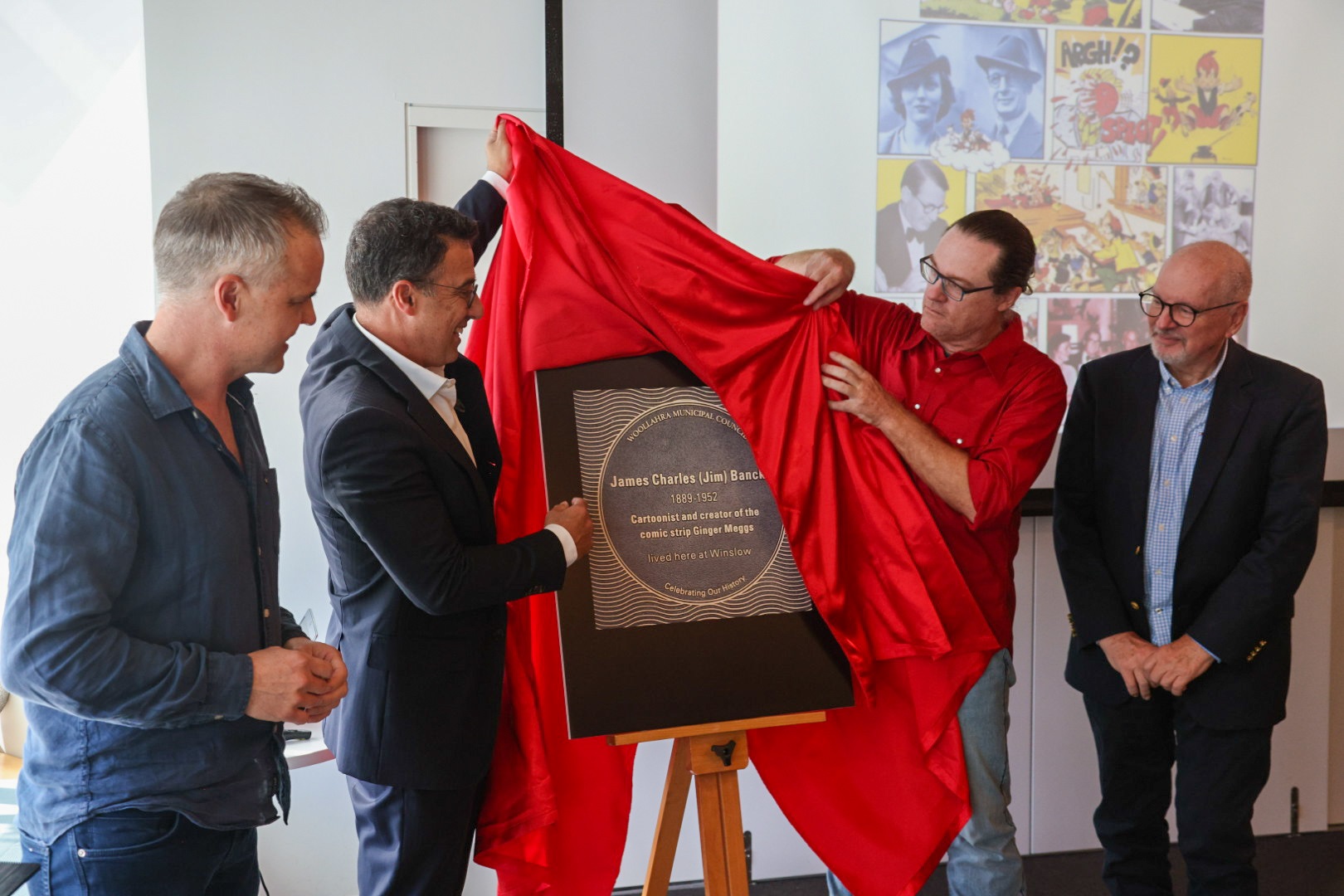
Plaque for James Charles Bancks (installed in Wentworth Place, Point Piper). Plaque officially unveiled at an event at Woollahra Library at Double Bay on 28 April 2023. L-R Tristan Bancks (Gt-gt Nephew of James Bancks and Guest Speaker), Cr Richard Shields, Erin Free and Graham Humphrey (joint nominators).
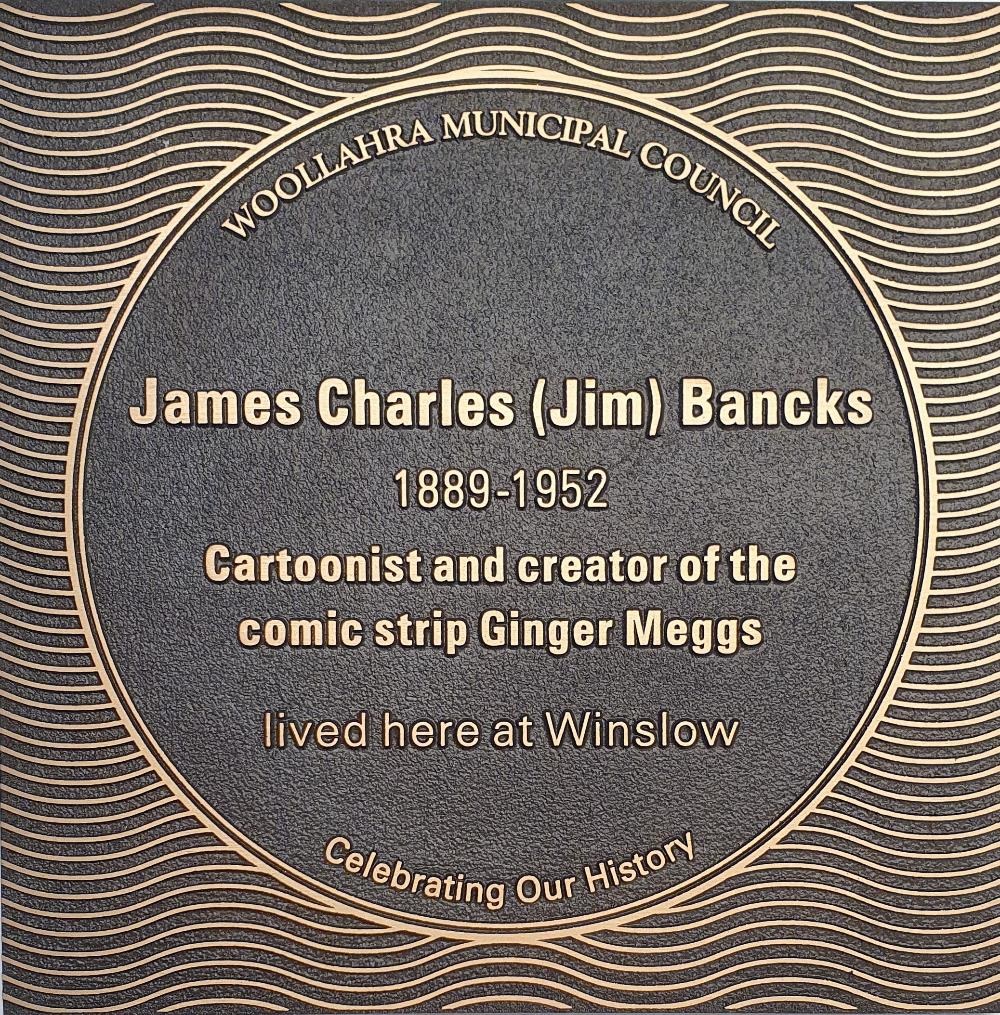
A plaque to commemorate the life and work of James (Jim) Bancks has been installed in Wentworth Place, Point Piper, at the rear of his former family home Winslow, 24 Wyuna Road. The plaque was officially unveiled at a ceremony at Woollahra Libraries on 28 April, 2023.
Unveiling Gallery
Guests L-R Geoff Weir (current owner of the Bancks house ‘Winslow’, Point Piper), Amber Melody, Tristan Bancks (Guest Speaker), Cr Mary-Lou Jarvis, Erin Free, Miranda Latimer, Michael Bancks, Kellie Sloane MP, Cr Richard Shields.
(JPG, 715KB)
James Charles (Jim) Bancks
10 May 1889 - 1 July 1952
Jim Bancks, cartoonist, was the creator of the iconic cartoon strip ‘Ginger Meggs’ - first published as ‘Us fellers’ (1921-1939) – which captured the ‘joys and tribulations’ of a suburban Australian childhood, and in Ginger Meggs, an unmistakably Australian character who was ‘part larrikin, part battler, part philosopher and part humourist’1. Ginger Meggs became one of Australia’s most popular and enduring comic strips, still published today in over 30 countries.
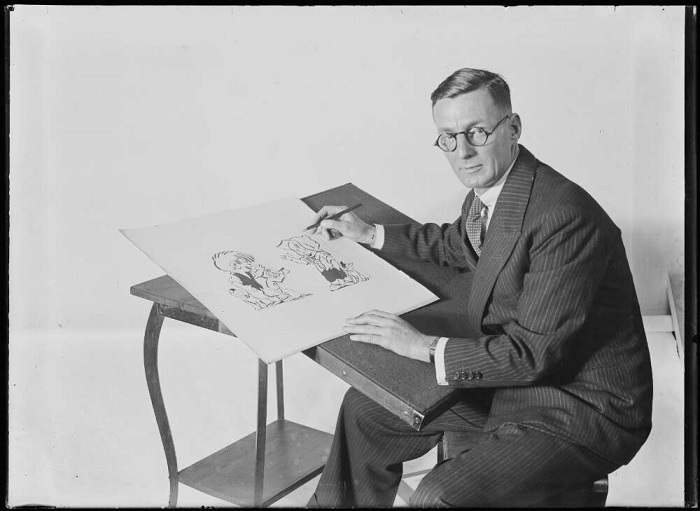
James Charles Bancks working on a Ginger Meggs cartoon sketch, Sydney, ca. 1920s. Fairfax Archive, National Library of Australia nla.obj-163038192.
Early Life
James Charles (Jim) Bancks was born at Enmore, Sydney, on 10 May 1889. His parents, John Spencer Bancks, an Irish railway-porter, and his wife Margaret, née Beston had married in 1886. The family moved to Hornsby c1892 and he remembered the family as a 'living comic strip'. Jimmy Bancks and his family left Hornsby in 1910.
Following an interview for PIX magazine in 1946 celebrating Ginger Meggs ‘25th year as Australia’s most popular comic strip character, Bancks was described as:
'the son of a lovable, irresponsible father, a philosophical, ends-meeting mother’ whose boyhood growing up in Hornsby had been ‘pleasant and in no way remarkable. He loathed school. While the rest of the class concentrated on listening to lesson, Jimmy would draw caricatures of the teacher. Like Ginger Meggs, Jimmy wagged school, “pinched” fruit, and frequently threatened to leave home, Dick Whittington style, to make his fortune. He made his fortune alright’. Australian Close-Up. Bancks: Creator of Ginger Meggs. Pix, 30 November 1946, Vol 18, No. 22
Bancks left school at 14, worked as a wool clerk, office-boy and lift-driver, and practised drawing in his spare time. ‘His first published cartoon appeared in the Sydney ‘Arrow’ when he was about 15. He was paid 10s 6d for it’2.
In 1911 his cartoons were published in the Comic Australian and, from 20 August 1914, in The Bulletin. After The Bulletin guaranteed him £8 a week for his drawings, he became a full-time artist and took lessons from Julian Ashton and Antonio Dattilo-Rubbo, working mainly as caricaturist and cartoonist.3 For a short time he advertised the ‘J C Bancks School of Sketching’ offering lessons by post.4
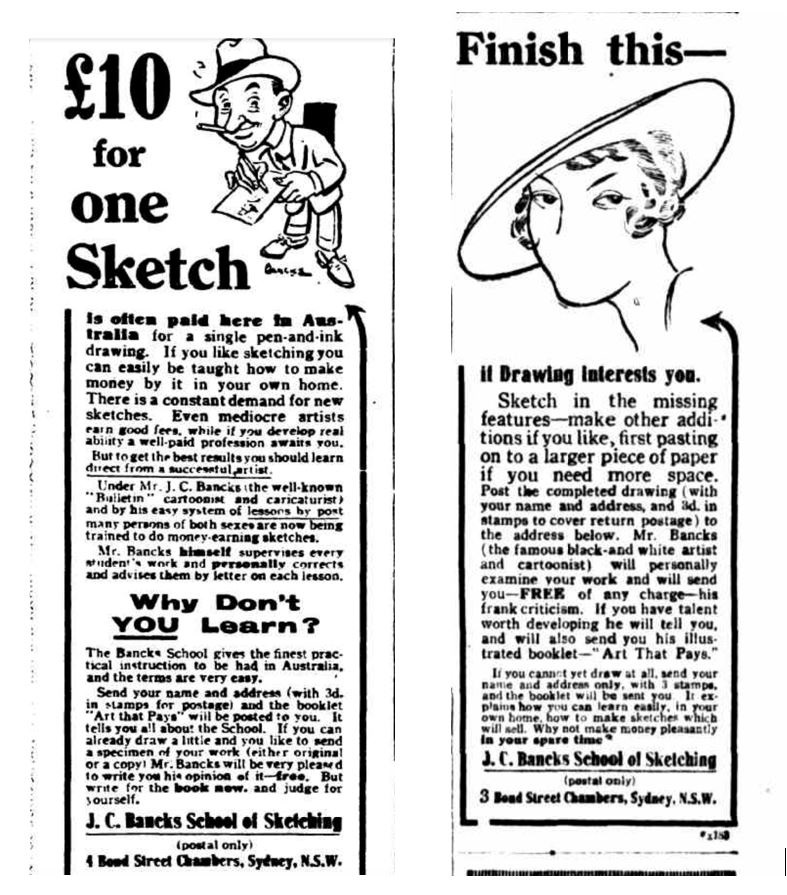
His most famous creation, the young Aussie larrikin ‘Ginger Meggs’, was introduced in the Sunday Sun in November 1921 in a children’s section called ‘Sunbeams’. The comic was called Us Fellers and was published intermittently over several months with Bancks eventually taking over writing the script as well as the drawings.
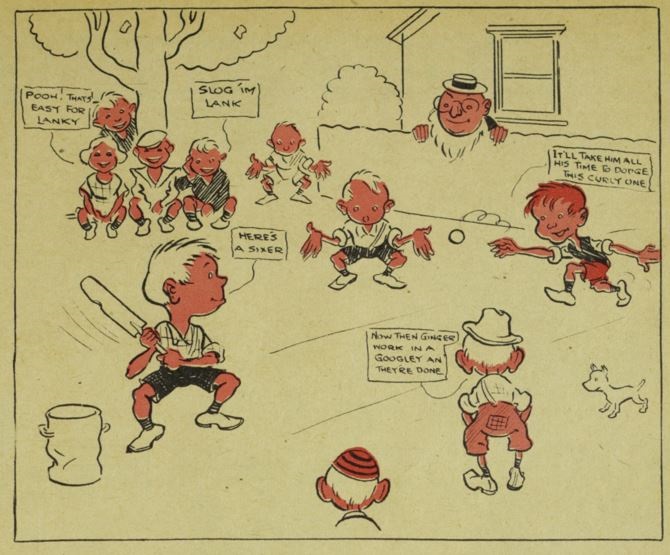
''Scene I, Strip I of Ginger Meggs’ entertaining life – “Sunday Sun" November 27, 1921'. Image and caption from 'Ginger Meggs – “Australia’s favourite son" ’, PIX, Vol 10 No. 24, 12 December 1942.
Ginger, originally a minor character called Ginger Smith, was renamed Ginger Meggs in 1922. According to local Hornsby lore, the hero of the cartoon was based in a real Hornsby identity. 'Those who knew both Bancks and my father accepted that the character of Ginger Meggs was based on Charles Somerville, who was one of Jimmy Bancks’ best mates’ (Hedley Somerville, A Taste of Ginger, p 68). By the time the comic strip appeared however, Charles Somerville was no longer the boisterous boy that Bancks had known: in fact he was a councillor on Hornsby Shire Council'5. Bancks also drew on his childhood experiences growing up in Hornsby, apparently ‘using names and places of the old neighbourhood without alteration. Frank Buckle, who became the first captain of the Northern District Cricket Team, scored a mention. So did George Lumby, a childhood friend who was now operating a hardware store in Hornsby. Ginger and his mates frequently stole fruit from Foster’s or Higgins’ orchard, which were local landmarks’5.
For the next thirty years, Bancks' creation was published weekly in the Sunday Sun and also, from 1924, in the Sunbeams Annual.6
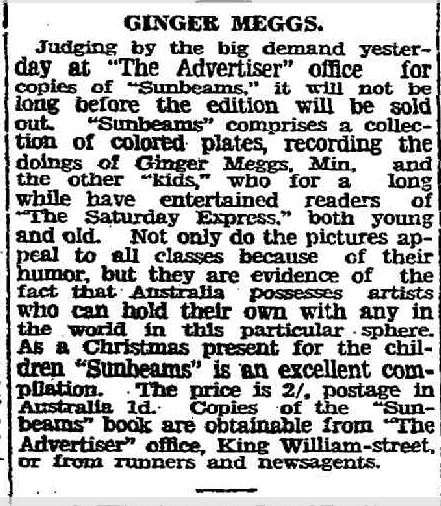
'Ginger Meggs', The Advertiser, 16 November, 1928 page 19.
In the late 1920s Bancks penetrated the overseas syndication market; by the time 'Us Fellers' changed its Sunday Sun title to 'Ginger Meggs' in November 1939, the strip had reached audiences in England and the United States of America as well as throughout Australia, and had been translated into French and Spanish for readers of La Presse in Montreal and El Muno in Buenos Aires. Bancks said that the most thrilling moment of his life was when he saw Ginger Meggs advertised on the newspaper posters in the Strand , London’.7 Plans to introduce the strip into Europe were largely thwarted by the outbreak of World War II, but it reached the Pacific via Guinea Gold, issued by the Australian Army.
Although the basic ingredients of the strip were established in its first year, Bancks artistic style and use of language developed over the ensuing years, while Ginger remained ‘sturdily optimistic, self-confident, cunning and quick-thinking; part larrikin, part battler, part philosopher and part humorist’.8
‘sketching and writing Ginge’s life, getting him in and out of favour with Min, having him “slam” Tiger Kelly with his “terrible straight right” and planning his cunning tricks for wheedling ice-creams from gullible kids has become a life work for his creator. As a result of Ginge’s popularity, Jimmy Bancks today is the highest paid comic artist in the Commonwealth. Australian Close-Up.Bancks: Creator of Ginger Meggs'.PIX 19469
Bancks was also the political cartoonist for the Evening Sun in Melbourne 1923-25 and became Australia's highest paid ‘black-and-white’ artist, receiving 80 pounds a week in the 1930s. Also known for his generosity, in 1946 Bancks funded a £1000 travelling scholarship for a ‘black and white artist under 25’. He also wrote for newspapers and was a popular after-dinner speaker.
In 1949 Bancks signed a new ten-year contract with Associated Newspapers Ltd, but repudiated it in 1951 when the company failed to fulfil its obligation to publish 'Ginger Meggs' on the front page of the Sunday Sun's comic supplement. Bancks won the ensuing court cases and Ginger Meggs moved to The Sunday Telegraph on June 3, 1951. According to Ken Hall, an old friend, Bancks was to be paid “£10,000 a year’. There was a front-page promotion for Ginger with a drawing of him asking, “How do you like me, kids, in my new, brilliantly coloured Sunday Telegraph clobber?” Writing in Cartoonists of Australia, compiled by Richard Rae, Ken Hall said Bancks “was my best friend and I think I knew him as well as many did. My patent admiration was shared by everyone who knew him and he had a legion of friends.”
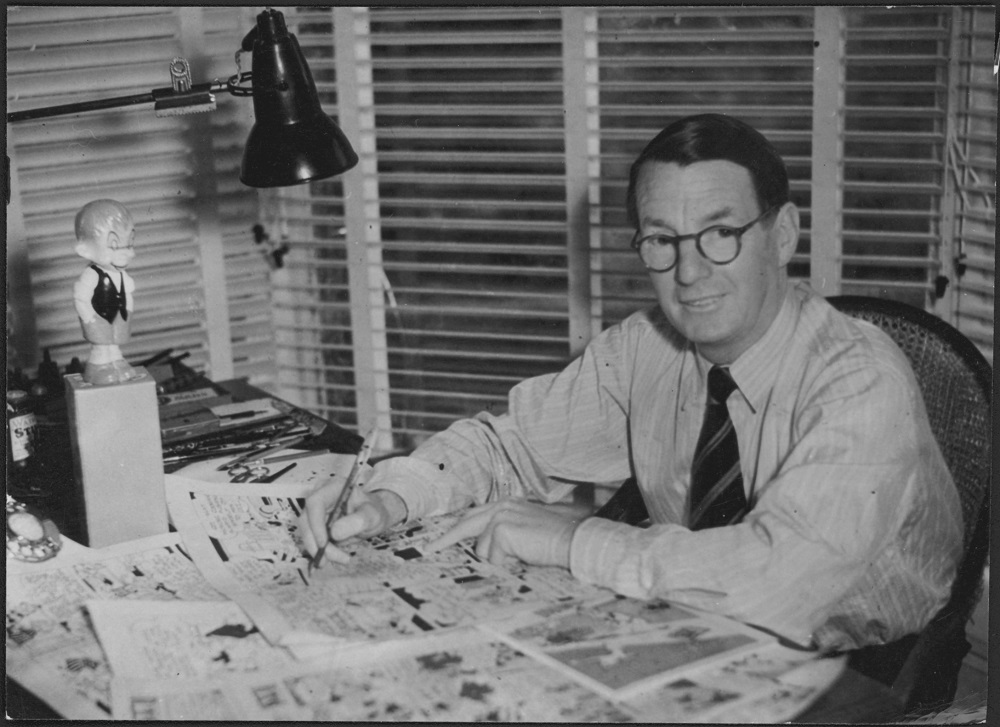
Portrait of cartoonist James Bancks c1945. National Library of Australia PIC9385 [working in his studio at home - 'Winslow', Point Piper].
'To Jimmy Bancks, Ginge was ‘a living, breathing 10-year-old boy. He has become the pivot of the artist’s life. Mrs. Bancks, who has a pleasant sense of humor, admits that she has always played second fiddle to a comic strip. Wherever he goes, whatever he does, Jimmy cannot escape from his creation. Fortunately for two million Australian readers, he doesn't want to’ Australian Close-Up. Bancks: Creator of Ginger Meggs'. PIX 1946.9
Following his return to Sydney in the mid 1920s, Bancks met and married Jessie Nita Tait, daughter of Edward Tait from the family of concert, film and theatrical entrepreneurs and J. C. Williamson's theatrical enterprise. When Jimmy Bancks and Jessie married on 15 October 1931 at St Mark’s, Darling Point, the wedding ‘aroused considerable public interest, and a crowd gathered outside the church’10, including a number of small boys who ‘had gone to see the originator of their favourite – Ginger Meggs and his pals’11. Jessie Tait was well known as a stage and dress designer, and collaborated with Bancks on the dialogue and costumes for the musical comedy Blue Mountain Melody, staged in 1934.
During the 1930s, Us Fellers continued to thrive and Bancks was earning a sizeable income. Jessie Bancks worked for Frank Packer as the fashion editor on the Australian Women’s Weekly and was involved in a number of charities. Packer and Jimmy Bancks, “used to play golf together regularly’ and Bancks had often been a guest at the Packers home in Darling Point. In 1936 tragedy stuck, when Jessie died in childbirth12.
From 1931 Bancks lived in Edgecliff and Bellevue Hill before moving to Point Piper c1938.13 In 1938 Bancks married for a second time to Patricia Quinan, travelling to America for a quiet wedding.
Bancks and his wife Patricia acquired two adjacent parcels of land at Point Piper - 24 Wyuna Road in 1938, with a house and street frontages on Wyuna Road and Wentworth Place, and land at 26 Wyuna Road in 1939 (sold in 1949)14. They moved into the house at 24 Wyuna Road, which had been built for a Dr William Henry Weston c1930 and named Morny.
Both properties were formerly part of a much larger land parcel consisting of Lots 7, 8 and 9 of Section 5 of the Point Piper Estate, offered for sale in 1899 and acquired by Dr. Colin McMaster who built a large house he named Crona (later called Loloma). The land parcel was re-subdivided in 1918, 1936 and 1940, eventually forming 5 lots, and the original house was eventually demolished.14
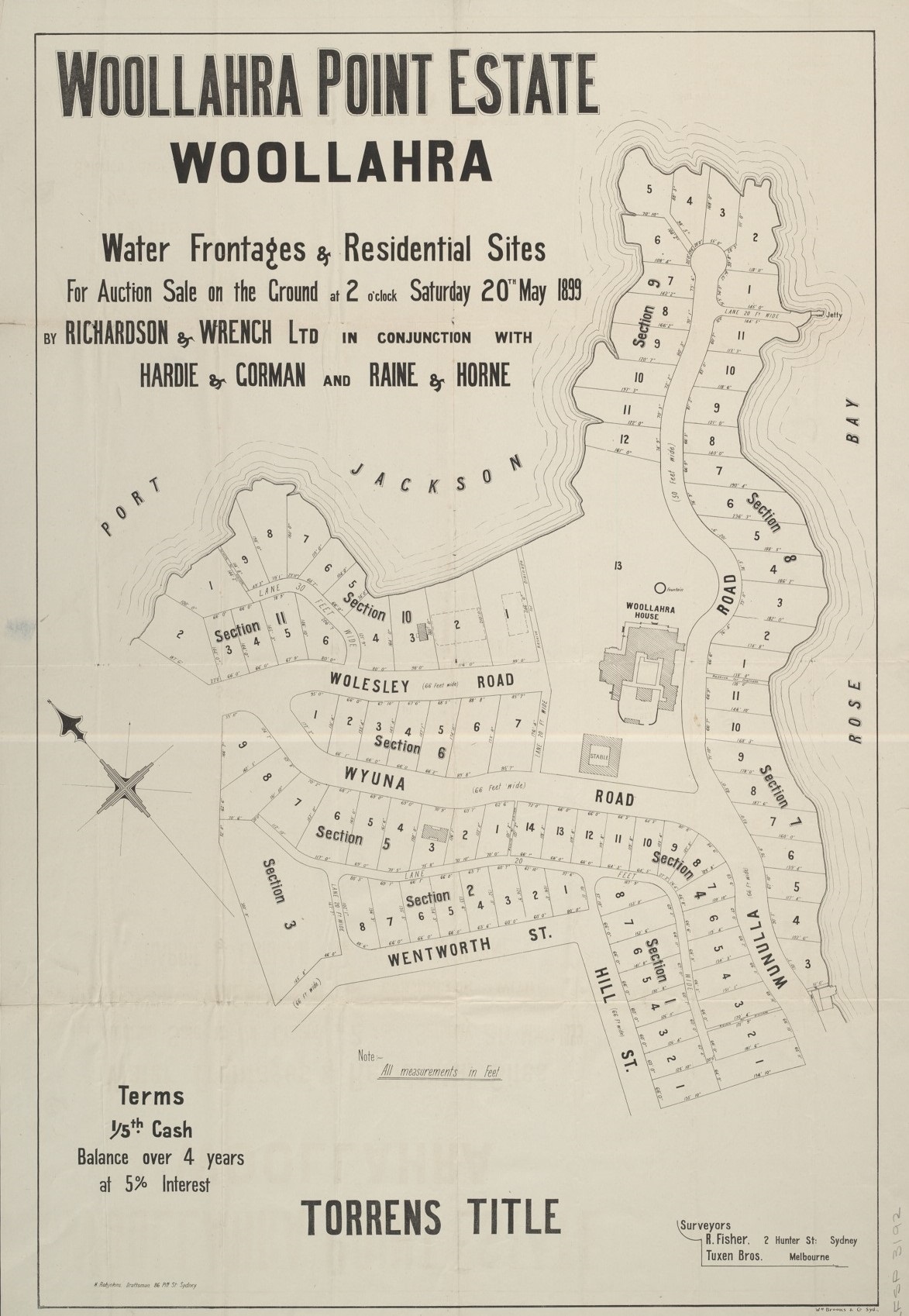
'Woollahra Point Estate: Water Frontages & Residential Sites'. Auction Sale Saturday 20th May 1899. Source: National Library of Australia.
The house at 24 Wyuna Road was renamed 'Winslow' - the name can still be found (as of January 2023) on the Wentworth Place frontage - and Jim Bancks worked from home in a studio downstairs. They adopted a daughter, Sheena [Sheenagh] in 1944, who remembered him sitting at his desk drawing Ginger Meggs.

'Australian Close-Up. Bancks: Creator of Ginger Meggs' Pix 30 November 1946, Vol 18, No. 22
Bancks does his work in a comfortable downstairs room at his Point Piper home. He works in the mornings and he works hard. His wife alleges that lately he is inclined to leave his drawing board and wander upstairs to play with Sheenagh. 'Jim Bancks: 25 years of childhood'. The Daily Telegraph November 16, 1946 p15.15
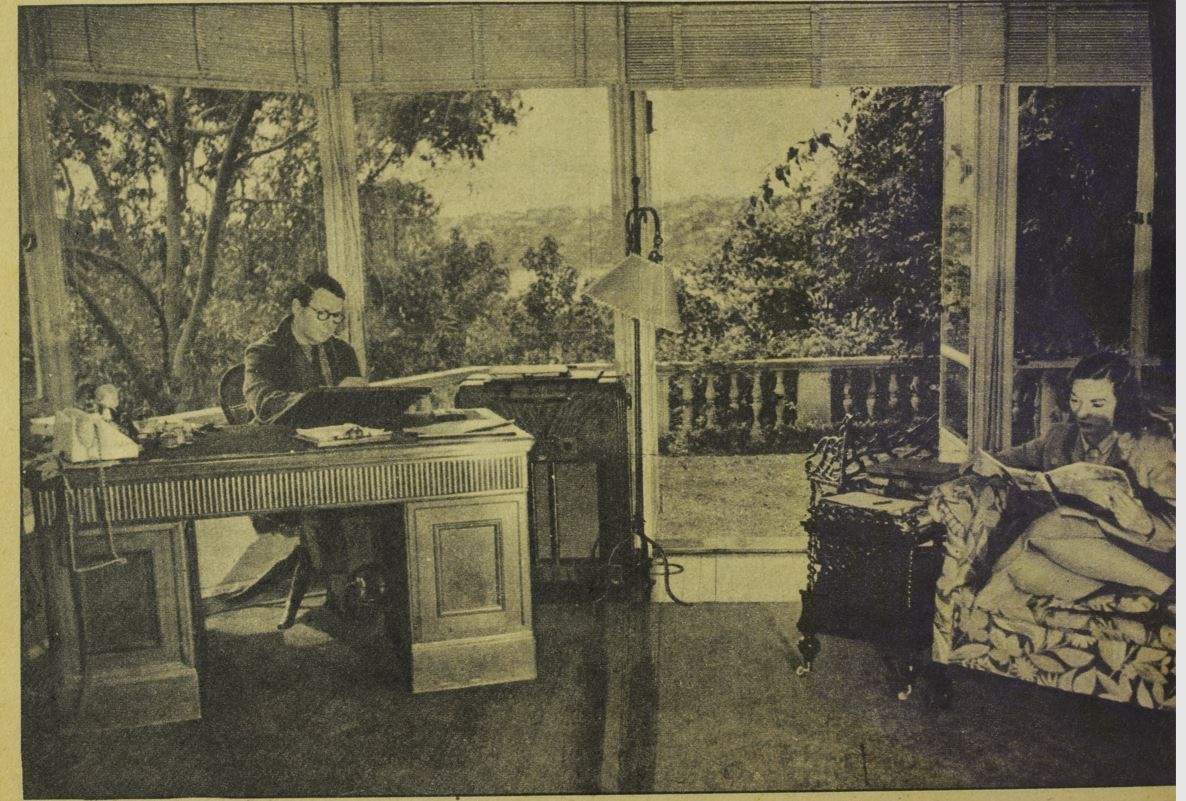
'Works At Home: In This Studio At His Home, “Winslow," Point Piper, overlooking Sydney Harbour, Jimmy Bancks limns [draws] the week-to-week scrapes and triumphs of Ginger. Mrs. Patricia Bancks sits reading. Image and caption from “‘Ginger Meggs - Australia’s favourite son”. PIX December 12, 1942 16
The Rev. Goodwin, speaking at Bancks' funeral at St Marks, Darling Point in 1952, said that ‘Jimmy Bancks will not be forgotten. His name will be blazoned on the uncompiled honour roll of Great Australians. It will be placed there by public opinion’17
Intentionally or unintentionally Meggs was the realization of everything our national image needed to be. He was Australian. There was no trace of imitation American or British about him. He was independent, rebelled against authority, as had our soldiers in the war. He laughed when things did not go his way, which was more often than not and he did not suffer bullies. There was never much money in Meggs’ life but a fair go was more important than greed. The only way he could have been more Australian was to have big feet and a long tail or live in a tree and eat gum leaves. There was not much he was missing from Henry Lawson’s Joe Wilson, Banjo Paterson’s the Man from Snowy River or C J Dennis’ Sentimental Bloke mould and he was only ten" Foyle, Lindsay. James (Jimmy) Charles Bancks, Australian Cartoonists Hall of Fame18
Bancks did not receive any public honours during his lifetime, but following the news of Banck’s death, NSW Premier Mr Cahill remarked that:
‘in its own way his work attained a degree of national importance'. Many people who have never known him personally will miss him. Those who did know him will remember him for his fine personal qualities and kindness. He was Australia’s Walt Disney’.19
Bancks was included in the Australian Cartoonists Association (ACA) Hall of Fame in 2009.20
Jimmy Bancks died on the 1st of July 1952 at Point Piper, Sydney, but his legacy endures - the Ginger Meggs comic strip is still published some 70 years after Bancks’s death, created by a succession of cartoonists, in over 30 countries. A 1946 article foresaw Ginger Meggs longevity - ‘This time 25 years hence, if the world and Jimmy Bancks last, there will still be Ginger Meggs. He might be flashed to you each Sunday morning via television—but he will still be 10, still sparring with Tiger Kelly, still consuming ice-creams, still saying “Golly!” For that’s the way Jimmy has planned it. Ginge is ourselves when young. He must never grow up’.21
In May 2021, a volume of four short stories titled Ginger Meggs was published to celebrate ‘100 years of the iconic character and Aussie legend Ginger Meggs’, written by children’s author Tristan Bancks, Jimmy Banck’s great-great nephew, and illustrated by Jason Chatfield, the current cartoonist. In his tribute to Jimmy Bancks, Tristan wrote:
‘From the 1920s to the 1950s no fictional creation embodied Australian national character like Ginger Meggs. In terms of notoriety, he was the Aussie Bart Simpson of his time. His personification of an idealised Australia spawned two feature films, four stage plays, more than fifty ‘annuals’ and made his creator, J.C. Bancks, the highest paid black and white artist or journalist around. Meggs is the longest-running and most popular comic strip in Australian history and is now read in 34 countries around the world.22
‘Ginger Meggs Park’ was created in 1997 in the Hornsby area, where Jimmy Bancks grew up.
Australian Cartoonists Association (ACA) Hall of Fame http://www.cartoonists.org.au/stanleys/halloffame/bancks_jimmy
Australian Dictionary of Biography https://adb.anu.edu.au/biography/bancks-james-charles-jim-5119/text8557
Griffiths, G. Nesta. Point Piper, Past and Present, Sydney : Ure Smith, 1970
TROVE (Newspaper and Journal articles)
Woollahra Council Records
Woollahra Libraries Local History Digital Archive
1 B. G. Andrews. Bancks, James Charles (Jim) (1889–1952), Australian Dictionary of Biography, https://adb.anu.edu.au/biography/bancks-james-charles-jim-5119/text8557
2 'Australian Close-Up. Bancks: Creator of Ginger Meggs'. Pix, 30 November 1946, Vol 18, No. 22. http://nla.gov.au/nla.obj-468973134 [An interview with PIX staff writer Helen Bridgefoot]
3 B. G. Andrews. Bancks, James Charles (Jim) (1889–1952), Australian Dictionary of Biography
4 Advertising . The World's News November 19, 1921 p. 26. http://nla.gov.au/nla.news-article128697511; Advertising Chronicle 1921, July 2, 1921 p. 15. http://nla.gov.au/nla.news-article89252397
5 Ginger Meggs - Hornsby's Larrikin. Hornsby Shire. 23rd Apr 2021. https://hornsbyshire.recollect.net.au/nodes/view/2225
6 Front cover of the first Ginger Meggs annual 1924 Hornsby Shire, 25th May 2018. https://hornsbyshire.recollect.net.au/nodes/view/2238
7 ‘Australian Close-Up. Bancks: Creator of Ginger Meggs’. Pix, 30 November 1946, Vol 18, No. 22
8 B. G. Andrews. Bancks, James Charles (Jim) (1889–1952), Australian Dictionary of Biography
9 ‘Australian Close-Up. Bancks: Creator of Ginger Meggs’. Pix, Vol 18, No. 22, 30 November 1946
10 'Many Spectators'. The Labor Daily, October 16, 1931, p. 10. http://nla.gov.au/nla.news-article236689687
11 ‘Their Hero’. The Sun, October 16, 1931 p. 11. http://nla.gov.au/nla.news-article223670191
12 ‘Obituary’. The Sydney Morning Herald, p. 11. November 23, 1936. http://nla.gov.au/nla.news-article17284792
13 Between 1931 and 1938 Bancks lived at a number of addresses in the Woollahra Municipality: Coromandel, Sutherland Crescent, Edgecliff c1931-1936; 55 Victoria Road, Bellevue Hill c1937; Kenilworth, Longworth Avenue, Point Piper, c1938. He lived at Winslow, 24 Wynua Road, Point Piper (previously named Morny) from c1939 until his death in 1952. (Sources: Australian Electoral Rolls 1933 - 1943; NSW Valuer-General Valuation List, 1937 (with annotations); WMC and NSW Valuer-General Rate, Assessment and Valuation Books, 1937-1952) Although some online sources suggest that Bancks lived at Deloraine, 132 Wolseley Road, Point Piper, no evidence could be found to support this in Council’s Rate and Assessment records or electoral rolls. Bancks' home address was also sometimes given as Wentworth Place, Point Piper (possibly as No. 5) as the property has a frontage to Wentworth Place, however this alternate street address is not apparent in official sources consulted (Land Registry Services and Woollahra Council Mapping Services).
14 Land Registry Services HLRV Vol-Fol 2888-16 (24 Wyuna Road) and Vol-Fol 4820-153 (26 Wyuna Road). For re-subdivision plans see Woollahra Libraries Digital Archive: https://lhc.woollahra.nsw.gov.au/collections/?record=ecatalogue.110101 and https://lhc.woollahra.nsw.gov.au/collections/?record=ecatalogue.110468 and https://lhc.woollahra.nsw.gov.au/collections/?record=ecatalogue.110384
15 'Jim Bancks: 25 years of childhood' The Daily Telegraph, November 16, 1946.p. 15. http://nla.gov.au/nla.news-article248364510
16 ‘Ginger Meggs – “Australia’s favourite son’, PIX, Vol 10 No. 24, 12 December 1942. p 28. https://nla.gov.au:443/tarkine/nla.obj-436898090
17 ‘City's last tribute to artist Jim Bancks’The Daily Telegraph 3 July, 1952, p. 7http://nla.gov.au/nla.news-article248644602
18 Foyle, Lindsay. James (Jimmy) Charles Bancks, Australian Cartoonists Hall of Fame, https://cartoonists.org.au/stanleys/halloffame
19 Cartoonist J. C. Bancks Dies. The Sydney Morning Herald, July 2, 1952, p. 4 http://nla.gov.au/nla.news-article18271411
20 Foyle, Lindsay. James (Jimmy) Charles Bancks, Australian Cartoonists Hall of Fame.
21 'Australian Close-Up. Bancks: Creator of Ginger Meggs'. Pix, 30 November 1946, Vol 18, No. 22
22 https://www.tristanbancks.com/2011/07/ginger-meggs-90th-birthday-tribute-to.html
New plaques are added based on nominations from the community, which are then assessed against selection criteria and researched by a Local History Librarian.
Find out more and nominate a person or event for a plaque.